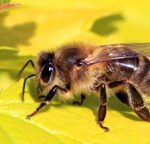Here are some items of note from Wisconsin State Laboratory of Hygiene (WSLH) scientists from the past few months –
Newborn Screening Receives New Disorders Implementation Award
 The WSLH Newborn Screening Laboratory received a New Disorders Implementation Award from the Association of Public Health Laboratories (APHL).
The WSLH Newborn Screening Laboratory received a New Disorders Implementation Award from the Association of Public Health Laboratories (APHL).
The award provides funding for the WSLH to become a Peer Network Resource Center and to develop next-generation sequencing 2nd tier testing to find underlying genetic causes for three disorders – Pompe, Mucopolysaccharidosis 1 (MPS-1) and X-linked Adrenoleukodystrophy (X-ALD).
As a Peer Network Resource Center, led by Dr. Mei Baker, the scientists at the Newborn Screening Laboratory and the UW Biotechnology Center will serve as content area experts and offer newborn screening, educational training, and/or technical assistance to other newborn screening programs. Wisconsin is one of only three state newborn screening programs to be funded as a Peer Network Resource Center.
Once validated, the 2nd tier next generation sequencing analysis that the WSLH and UW Biotechnology Center are developing will be offered to states that have already implemented 1st tier newborn screening testing for these disorders.
APHL news release – http://www.marketwired.com/printer_friendly?id=2193375
Research Looks at Method to Extract Cryptosporidium from Soil to Aid in Drinking Water Analysis

Image credit: CDC
The parasite Cryptosporidium was responsible for the largest documented waterborne disease outbreak in United States history when in 1993 in Milwaukee it caused illness in more than 400,000 people and the deaths of at least 69 people. When the pathogen is present in drinking water supplies, it is a serious threat to humans. But how does it get into the water?
Researchers suspect that one route is through soil. And while USEPA has published a method to analyze drinking water for Cryptosporidium (USEPA Method 1623.1), there is no comparable USEPA soil extraction method.
To overcome this barrier, scientists at the Wisconsin State Laboratory of Hygiene (Dr. Sharon Long and Jeremy Olstadt), the University of Wisconsin-Madison Department of Biological Systems Engineering, and UW-Madison Department of Soil Sciences (Dr. Long) developed and evaluated a Cryptosporidium soil extraction method capable of producing an extracted fluid containing the pathogen that could be purified and enumerated using USEPA Method 1623.1.
Their research is published in Agricultural and Environmental Letters – “Cryptosporidium Soil Extraction by Filtration/IMS/FA Compatible with USEPA Method 1623.1”
What’s Killing the Honey Bees?

Honey bee, Apis mellifera. Photo by Charlesjsharp – Own work, from Sharp Photography, sharpphotography. Used under the Creative Commons Attribution-ShareAlike 3.0 Unported license.
For several years, scientists, farmers and beekeepers have raised alarms about the increasing loss of honey bee hives. Honey bees play a key role in food production for humans by pollinating flowering crop plants.
An article in PLOS One, recounts the discovery of one bacterium that may be playing a part in honey bee hive loss – Serratia marcescens Strain Sicaria (Ss1). WSLH Communicable Disease Division Deputy Director Dr. David Warshauer contributed to the research.
“Sepsis and Hemocyte Loss in Honey Bees (Apis mellifera) Infected with Serratia marcescens Strain Sicaria” (PLOS One)
